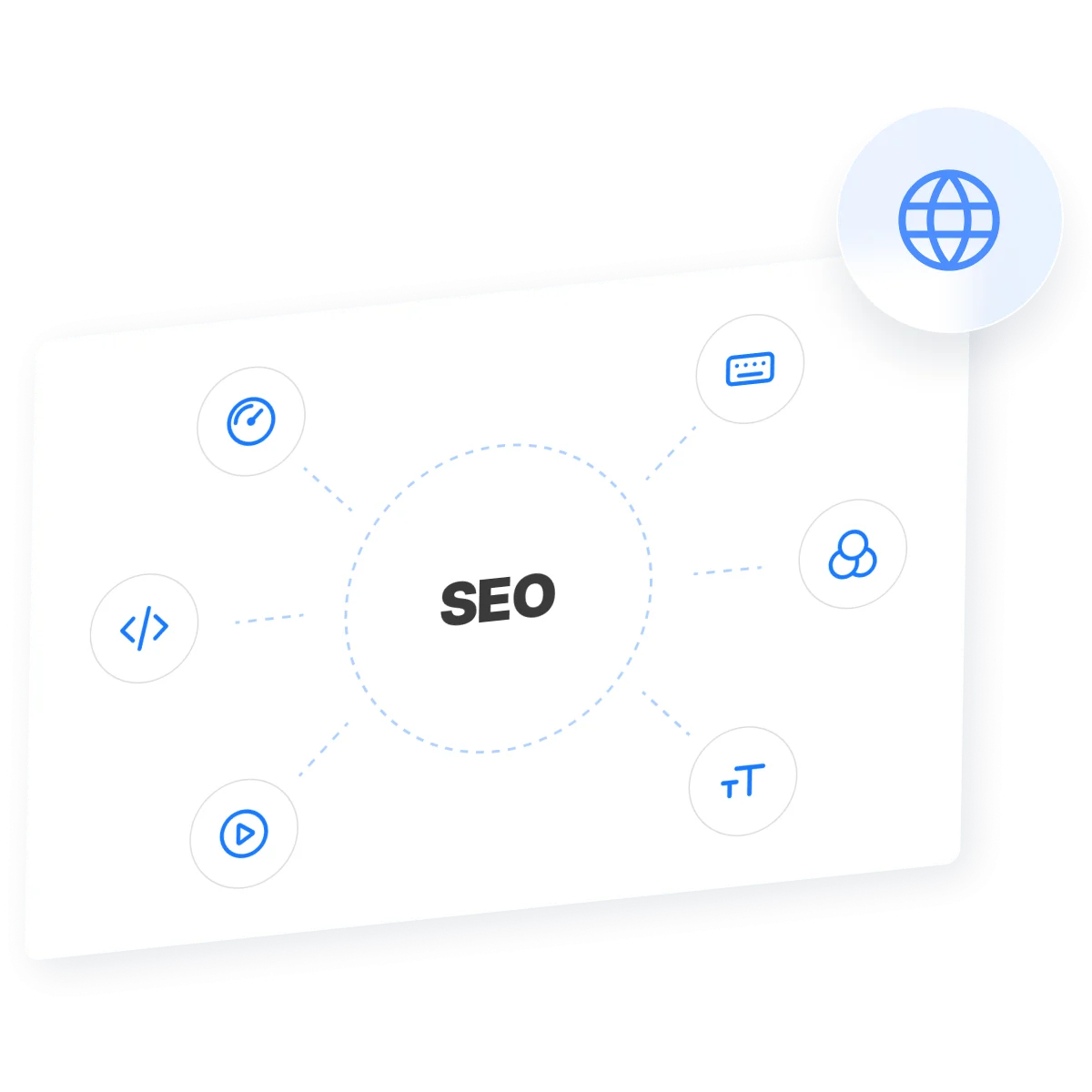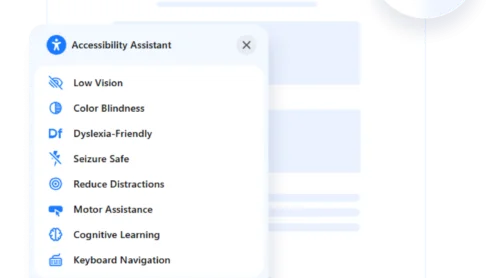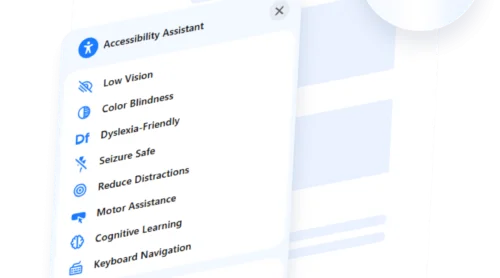Today, accessibility is no longer just a moral or legal responsibility — it’s a major asset for boosting your digital presence. When a website becomes accessible, it improves the overall experience for every visitor, not just for people with disabilities. This directly enhances user engagement, time on page, and ultimately, search engine rankings.
Accessibility and SEO are deeply interconnected. Search engines prioritize websites that offer a seamless, inclusive experience, rewarding them with better visibility and higher organic rankings.
Some of the most important advantages of making a website accessible include:
- Creating a more user-friendly environment. Simple navigation, readable text, and clear layouts benefit all visitors, not just users with disabilities.
- Boosting organic search visibility. Accessible websites tend to rank higher because they provide better structure, clarity, and user engagement.
- Reducing bounce rates. When users find a website easy to navigate and interact with, they stay longer and explore more pages.
- Expanding audience reach. An accessible website welcomes users from all demographics, including those using assistive technologies.
- Strengthening brand reputation. Businesses that prioritize accessibility are seen as more socially responsible and inclusive.
- Aligning with legal standards. Meeting accessibility guidelines helps minimize legal risks related to discrimination laws.
Understanding why accessibility matters is the first step toward creating a digital space where everyone feels welcome — and where your SEO efforts can truly shine.
Relationship Between Accessibility and SEO
The relationship between web accessibility and SEO is much deeper than many realize. It’s not only about making a website accessible to users with disabilities — it’s about creating a better, clearer experience for everyone. Interestingly, many elements that enhance accessibility are the same ones that improve SEO. This overlap means that working on one area naturally strengthens the other.
From a search engine’s perspective, an accessible website is easier to crawl, index, and rank. Features like structured heading hierarchies, meaningful alt text, readable font sizes, and descriptive link text help both users and search bots understand the page’s purpose faster. This alignment between accessibility enhancements and SEO best practices ensures that improvements aimed at human users also please algorithms.
Furthermore, the impact of accessibility on SEO is visible in key ranking factors such as user engagement metrics. For example, a website that is easier to navigate leads to longer session durations, lower bounce rates, and higher interaction rates— all strong signals that influence organic rankings. Accessibility improvements create a ripple effect, enhancing usability, boosting visitor satisfaction, and making your digital presence more competitive in search results.
How ADA Compliance Affects SEO Performance
While web accessibility enhances usability, ADA compliance and SEO introduce a legal dimension that amplifies the importance of inclusive web design. The Americans with Disabilities Act (ADA) requires businesses to ensure their websites are usable by individuals with disabilities. Failure to comply with these standards doesn’t just invite legal issues — it can seriously undermine a website’s SEO performance, customer trust, and online reputation.
ADA Compliance and Search Engine Visibility
Search engines favor websites that are structured, user-friendly, and accessible to all users. Key accessibility improvements like alt text for images, proper heading hierarchies, consistent navigation, and mobile responsiveness are crucial ranking factors.
Meeting legal requirements for online accessibility ensures your website is technically optimized for better crawling, indexing, and ranking. These enhancements help search engines interpret your content more efficiently, boosting your visibility across organic search results.
Integrating accessibility features naturally aligns with Google’s evolving emphasis on user experience, making it an essential part of any long-term SEO strategy.
Legal Risks and SEO Disruption
Non-compliance with ADA standards can trigger lawsuits, mandatory fixes, and reputational damage — all of which disrupt SEO campaigns. A sudden legal penalty could lead to domain penalties, loss of earned backlinks, damaged brand authority, and serious organic traffic declines. Adapting early to compliance with accessibility laws shields your digital presence and preserves the stability of your search engine rankings.
Building Trust, Authority, and Audience Reach
Compliance also plays a major role in public perception. Accessible websites send a strong message about brand values, demonstrating inclusivity and social responsibility. This often results in longer user sessions, higher interaction rates, and more organic sharing — all critical behavioral metrics that feed back into stronger SEO performance.
The ADA and SEO relationship extends beyond compliance: it becomes a powerful brand-building strategy that enhances visibility and loyalty over time.
The Growing Importance of Compliance for SEO Strategies
Looking ahead, the importance of accessibility compliance for SEO is only expected to grow. As search engines continue to prioritize user experience signals, websites that fail to address accessibility will find themselves increasingly sidelined in competitive rankings.
Taking accessibility requirements into account when you’re planning your SEO strategies ensures that your website stays ahead of legal standards, technological trends, and consumer expectations.
Benefits of Accessibility for Website Rankings
Investing in accessibility is one of the smartest moves a business can make for SEO. Beyond fulfilling ethical and legal obligations, improving accessibility delivers substantial benefits of accessibility for SEO that help strengthen digital authority, enhance search rankings, and create lasting audience loyalty. A truly accessible website doesn’t just serve a wider audience — it sends strong positive signals to search engines about quality, usability, and relevance.
Some of the most impactful ways accessibility improvements boost your organic search visibility include:
- Improved crawlability. Clean code, structured headings, and semantic HTML make it easier for search engines to read and rank content accurately.
- Better content comprehension. Providing alt text for images and transcripts for videos enhances context, leading to richer search engine understanding and better content indexing.
- Lower bounce rates. Accessible layouts, readable fonts, and easy navigation encourage visitors to stay longer, signaling higher relevance to search algorithms.
- Increased engagement rates. Making content user-friendly for everyone boosts interactions, shares, and conversions — all essential behavioral signals for SEO success.
- Expanded audience reach. An accessible website welcomes users who rely on assistive technologies, opening the door to new traffic sources and improving the chances of higher search visibility.
Make Your Website Accessible and SEO-Friendly
Blending accessibility compliance and SEO into a unified strategy doesn’t have to be overwhelming. By following a clear, step-by-step approach, you can successfully build a website that welcomes every visitor while also improving search engine performance.
Here’s how you can start optimizing websites for all users and create a truly accessible digital environment.
Step 1: Structure Content with Logical Headings 📚
Use proper heading levels (H1, H2, H3) to organize your content clearly. A logical structure helps users with assistive technologies navigate easily and improves your SEO by making your content more understandable to search engines.
Step 2: Add Alt Text to All Images 🌄
Every image should have descriptive alt text that conveys its purpose. This not only assists users who rely on screen readers but also provides additional context to search engines, enhancing content relevance and boosting SEO visibility.
Step 3: Ensure Keyboard Navigability 💻
Make sure all interactive elements — menus, forms, buttons — are fully accessible via keyboard. This is critical for ADA compliance and directly influences usability metrics that search engines track for ranking purposes.
Step 4: Improve Readability and Visual Design 🎨
Use legible font sizes, sufficient color contrast, and simple language. Improving readability makes your content more accessible to a broader audience and supports better engagement, which benefits your SEO signals.
Step 5: Provide Text Alternatives for Multimedia 🎥
Videos should include captions and audio content should have transcripts. This ensures that all users can access your multimedia content, increasing time on page and strengthening the overall SEO performance.
Step 6: Optimize for Mobile Accessibility 📱
Responsive design is not optional — it’s essential. Accessible websites must be easy to use across all devices, and mobile usability is a confirmed ranking factor that impacts your SEO directly.
Step 7: Conduct Regular Accessibility Audits 🛠
Use accessibility checking tools to regularly audit your compliance status. These tests help you stay compliant with ADA standards and maintain a website that is optimized for search engines and users alike.
Improve accessibility on your website with Elfsight
If you’re aiming to make your website more inclusive and meet global accessibility regulations, the Elfsight accessibility widget is a reliable, no-code solution. It helps you align with ADA, WCAG, and EAA standards while enhancing usability for visitors with various disabilities.
- Preset modes for users with Low Vision, Color Blindness, Dyslexia, and more
- Built-in scanner to assess your website’s current accessibility level
- Fully compatible with all major platforms and available in 20+ languages
- Flexible styling and placement to fit any design
Just follow these simple steps to add the widget to your website:
- Set up your widget. Open the editor, pick a template, and customize the widget’s settings.
- Copy the integration code. Hit “Add to website for free” and copy the generated embed code.
- Insert into your website. Paste the code into HTML or embed section on your website.
Curious to see how it works? Build your widget right now!
Inclusive Language and Its Impact on SEO
While technical improvements are crucial, the words you choose on a website play an equally important role in accessibility and search engine success. Adopting inclusive language along with SEO practices helps make content welcoming to a broader audience and strengthens brand trust. Search engines increasingly favor websites that demonstrate sensitivity and awareness in communication style.
Inclusive language avoids bias, stereotypes, and exclusionary terms. It embraces diverse identities and experiences, making everyone feel seen and valued. This approach not only reflects positively on the brand but also enhances SEO by aligning with evolving user expectations and search behavior patterns.
Examples of Inclusive Language and Their Impact
| Inclusive Language Example | Effect on Website Visitors |
|---|---|
| Use “everyone” or “team” instead of “guys” | Makes communication more welcoming to all genders, encouraging broader audience engagement. |
| Say “chairperson” instead of “chairman” | Conveys gender neutrality, fostering a perception of fairness and inclusivity. |
| Use “partner” instead of “husband” or “wife” | Recognizes diverse relationships, making LGBTQ+ visitors feel included and respected. |
| Say “people with disabilities” instead of “the disabled” | Highlights person-first language, showing respect and reducing stigma. |
| Say “accessible parking” instead of “handicapped parking” | Uses empowering terminology, promoting a positive experience for individuals with disabilities. |
| Refer to “older adults” instead of “the elderly” | Uses respectful, age-inclusive language, enhancing comfort for older audiences. |
| Say “living with a condition” rather than “suffering from” | Promotes a strengths-based view, making health-related content feel more supportive. |
| Use “salesperson” instead of “salesman” | Eliminates gender bias, promoting professionalism and inclusivity. |
| Refer to “parents” or “caregivers” instead of “mom and dad” | Includes different family structures, making diverse visitors feel represented. |
| Say “Dear team” or “Dear all” instead of “Dear ladies and gentlemen” | Uses non-binary, inclusive greetings, creating a welcoming tone for all readers. |
These simple adjustments promote making content user-friendly and resonate better with modern audiences, leading to higher engagement and broader keyword targeting opportunities.
Integrating inclusive language strategies ensures that a website communicates with authenticity, respect, and clarity — all factors that enhance user experiences, drive better engagement metrics, and contribute to stronger search rankings.
How Search Engines Reward Accessible Websites
Accessibility improvements aren’t just about meeting standards — they directly influence how search engines evaluate and rank a website. Following SEO accessibility principles ensures that your website is easily understood by both users and crawlers, creating an environment where usability and technical performance work hand in hand.
Key Ways Accessible Websites Gain an SEO Advantage
- Improved Indexing. Clean code, clear headings, and descriptive alt text help search engines better interpret page content.
- Higher Engagement Rates. User-friendly layouts and accessible features reduce bounce rates and increase time on page — strong positive signals for SEO.
- Mobile-First Optimization. Many accessibility best practices align with mobile usability improvements, boosting performance in mobile-first indexing.
- Enhanced Content Discoverability. Transcripts, alt attributes, and readable content ensure that all information is accessible and visible to search engines.
- Broader Audience Reach. By accommodating users with disabilities, accessible websites expand their potential traffic sources, boosting organic visibility naturally.
Accessible websites are often rewarded with better rankings because they provide exactly what search engines seek: clear structure, outstanding user experience, and inclusive, valuable content.
Conclusion
As search engines continue to prioritize user experience, the connection between accessibility and SEO will only grow stronger. Creating an accessible website is no longer just a matter of compliance — it’s a strategic investment in boosting search performance, increasing audience reach, and building lasting trust.
By focusing on accessibility, businesses naturally improve the technical quality and usability of their online presence, positioning themselves ahead of competitors in an increasingly experience-driven search landscape.







